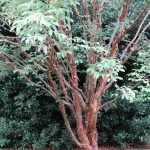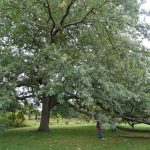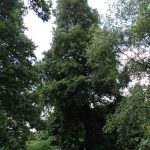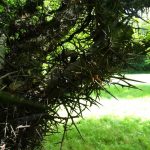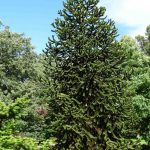Sunny periods and heavy thundery showers had been forecast for the afternoon of 9th September – and we got them both – when 19 members led by Renée Grayer went for a tree walk in the Harris Garden, the former botanical garden of Reading University. Renée handed out a list of some 50 tree species that we were going to see and she explained that the garden dates from 1975 just after the Botany Department moved from the London Road site to the new Plant Science Laboratories adjacent to the garden. In the second half of the 19th and first half of the 20th century the area had been part of the Wilderness Estate, one of the leaseholds into which Whiteknights had been divided when the Marquess of Blandford, who owned the whole estate, had become bankrupt. The group were shown a number of veteran trees planted in the former Wilderness estate in the 19th century, now tall and majestic, including Swamp Cypress Taxodium distichum, Caucasian Alder Alnus subcordata, Giant Redwood or Wellingtonia Sequoiadendron giganteum and Himalayan Cedar Cedrus deodara. There are also huge Turkey Oaks Quercus cerris and other species of oak that probably date from that period. We also saw unusual trees which had been planted more recently, some of them dedicated to the memory of university staff and students, including Judas Tree Cercis siliquastrum, Wheel Tree Trochodendron aralioides and Dawn Redwood Metasequoia glyptostroboides. Other trees had been planted for their interesting bark, such as Paper-bark Maple Acer griseum, Tibetan Cherry Prunus serrula and Hybrid Strawberry-tree Arbutus x andrachnoides, or autumn colours of the leaves, including Sweet Gum Liquidambar styraciflua, Persian Ironwood Parrotia persica and Tulip Tree Liriodendron tulipifera. The spiny trunks of Persian Honey-locust trees Gleditsia caspica and spiny leaves of the Monkey-puzzle Araucaria araucana were also admired by the group. One area of the garden is dedicated to unusual conifers and there we saw Tiger-tail Spruce Picea torano, Serbian Spruce Picea omorika and Cedar of Lebanon Cedrus libani. At that moment the pitch-black sky that had been approaching us fast started precipitating, so that we sheltered under the dense branches of the Himalayan White Pine Pinus wallachiana, which bears bundles of five needles instead of bundles of two as found in our native Scots Pine. But the rain, accompanied by hail and thunder, became so heavy that we still became soaking wet. When the rain had subsided some 15 minutes later we looked at two more trees, probably the most interesting conifers in the Harris Garden, which had been planted quite recently. They were the Wollemi Pine Wollemia nobilis and Dawn Redwood Metasequoia glyptostroboides. Both trees were only known from fossils, millions of years old, and thought to be extinct. Wollemi Pine was discovered in 1994 in the Wollemi National Park in Australia where about a hundred specimens were growing in a few steep-sides gorges which were hardly accessible. Since then the tree has been propagated successfully and distributed to botanical gardens all over the world. Now they are even available in garden centres. Dawn Redwood was found in China in the 1940s, but only one wood comprising some 5000 specimens is left in the wild. This tree has also been successfully propagated and has been planted widely since, especially in China itself.
Report by Renée Grayer
Pictures by Laurie Haseler

